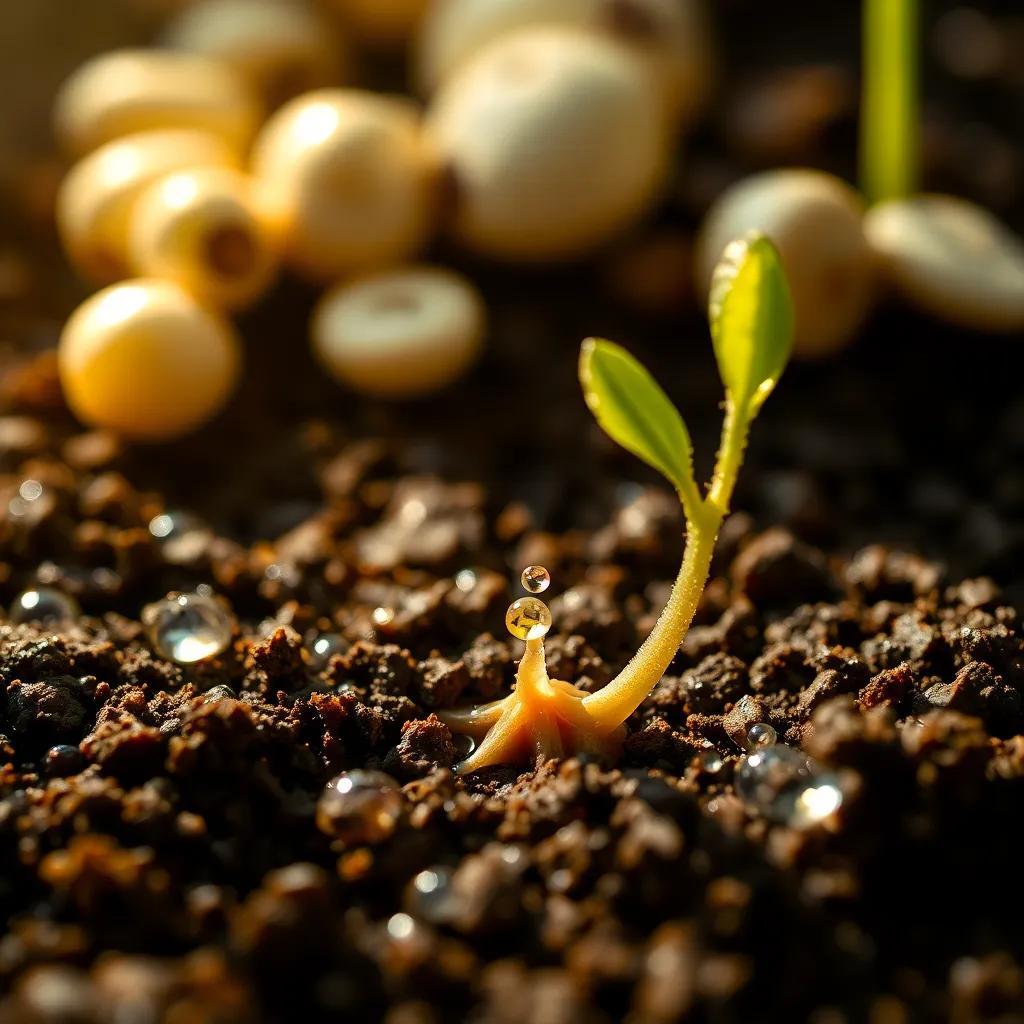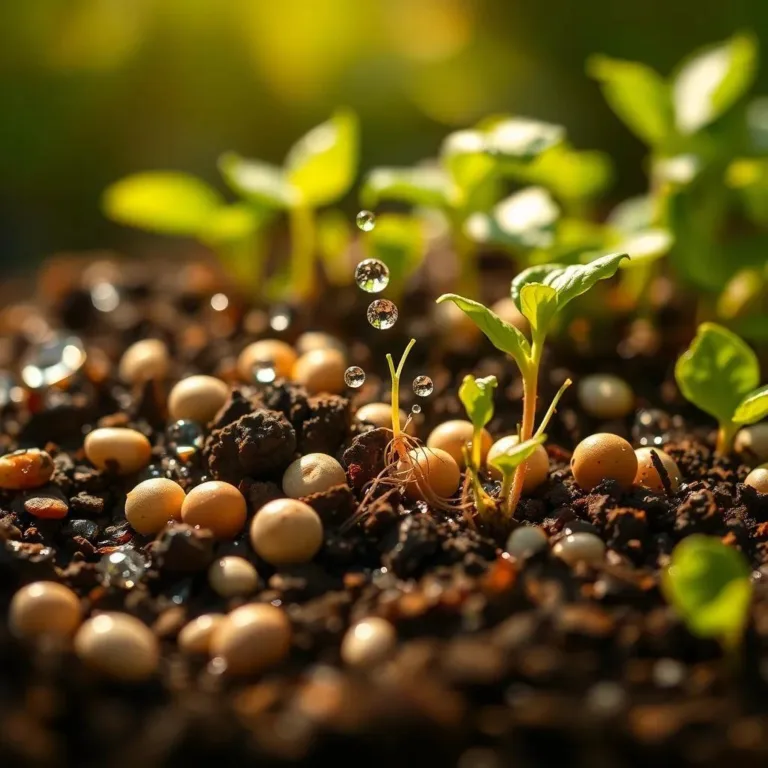Have you ever wondered how a tiny seed transforms into a flourishing plant? It’s a fascinating journey filled with magic and science! In this article, we’ll explore the incredible stages of seed germination and uncover the key ingredients—like water, light, temperature, and oxygen—that help these little heroes grow. Get ready to dig in and discover the wonders of nature!
Stages of Seed Germination and Growth
Germination is like a magical transformation that takes a little seed and turns it into a sprightly seedling! It’s a journey filled with several exciting stages, each crucial for the plant’s development. Let’s break it down!
- Imbibition: This is the first step, and it’s where the fun begins! The seed absorbs water like a sponge. As it soaks up the moisture, it swells, and the seed coat softens. It’s like the seed is waking up from a long nap!
- Activation: After soaking up water, enzymes inside the seed start to wake up and get to work. They break down the stored food, like starches and proteins, into forms the plant can use. It’s like a wake-up breakfast for the seedling!
- Emergence of the Radicle: This is where things get exciting! The radicle, or the tiny root, pushes through the seed coat and anchors into the soil. It’s like the seedling is saying, “Here I am, world! Ready to grow!”
- Shoot Growth: Once the radicle is secure, the shoot (called the epicotyl) starts to grow upward. This is where the first leaves, known as cotyledons, start to unfurl. These leaves are the seedling’s first solar panels, getting ready to catch some sunshine!
- True Leaf Development: As the seedling continues to grow, it will eventually produce true leaves. These leaves are specific to the plant species and are responsible for photosynthesis, turning sunlight into food.
Each stage is a vital step in the plant’s journey from a tiny seed to a thriving little plant. With the right conditions—like water, warmth, and care—your seeds can pull off this amazing transformation right before your eyes!
The Importance of Water in Seed Germination
Ah, water! The magical elixir that makes everything grow! When it comes to germination, water is the star of the show. Think of it as the starter ingredient in your favorite recipe—without it, nothing else works! Here’s why water is so important for those busy little seeds:
- Kicking off the Process: Water softens the hard seed coat, making it easier for the seed to sprout. It’s kind of like giving the seed a gentle nudge, saying, “Hey, it’s time to wake up!”
- Activating Enzymes: Once the seed absorbs water, enzymes come alive. These proteins are like mini chefs, breaking down stored nutrients into simpler ingredients that the seedling can use. Without water, these chefs would just be sitting around, twiddling their thumbs!
- Hydrating Cells: Water helps to hydrate the cells inside the seed. Hydrated cells are bouncy and ready to grow! They perform all the necessary metabolic processes to support the sprouting seedling, giving it the energy it needs to push through the soil.
- Delivering Nutrients: Water also acts as a delivery service for nutrients. It dissolves essential minerals and carries them to the roots as they grow. This is super important for the little plant to stay healthy and strong.
- Promoting Respiration: Finally, oxygen is necessary for respiration, and water helps facilitate this process. Seeds need oxygen to convert stored food into energy. Just like we need snacks during a long movie, seeds need oxygen to keep growing!
So, when you think about germination, just remember: water is the key ingredient that helps those seeds grow into beautiful plants! Keep the soil moist, but not soggy, and watch your little garden thrive!

Light’s Influence on Seed Germination
Light is like the secret magic ingredient that can make the germination process even more exciting! While not all seeds need light to sprout, for those that do, it can really amp up the whole experience. Let’s peel back the layers on how light plays a role in getting those seeds to grow!
- Photoblastic Seeds: Some seeds are a bit picky. They actually rely on light to start germinating! Seeds that respond positively to light are called photoblastic seeds. They need that sunlight as a cue to kick off the germination party!
- Light Activation: When these seeds receive light, they get activated in awesome ways. The light stimulates the production of hormones, like gibberellins, which help the seedling grow taller and stronger. It’s like giving the seedlings a boost of energy!
- Light and Darkness: Not all seeds crave light. Some prefer to stay in the dark! These seeds, called negatively photoblastic seeds, only germinate when buried deep in the soil. It’s like they want to keep their growth a secret until they’re ready to burst into the world!
- Seed Depth Matters: The depth at which you plant a seed can determine how it interacts with light. Seeds that need light should be planted just beneath the soil surface, while those that want darkness should be tucked in a bit deeper. It’s all about knowing what your seeds prefer!
- Continued Growth: Even after germination, light remains essential. As the seedling stretches towards the sky, it needs light for photosynthesis. This process is how plants turn sunlight into food, fueling further growth. Without light, our little plants would struggle to thrive!
In a nutshell, light is a superstar in the germination process, guiding seeds to sprout and helping seedlings flourish. So, when you’re planting seeds, keep their light needs in mind. It could be the difference between a sleepy seed and a lively little plant ready to greet the world!
Temperature Requirements for Successful Germination
Temperature is another key player in the germination game! Just like us, seeds have their ideal temperature zones that make them feel comfy and ready to sprout. Let’s check out how temperature impacts our little green friends!
- Germination Range: Each plant species has its own preferred temperature range. Most seeds germinate best between 15-30 degrees Celsius (59-86 degrees Fahrenheit). Imagine a cozy blanket of warmth; that’s what seeds are looking for!
- Enzyme Activation: Temperature is super important for enzyme activity. Warm temperatures help enzymes spring into action, breaking down stored nutrients for the seedling to munch on. If it’s too cold, the seeds might hit the brakes on growth!
- Respiration Rates: Germination requires energy, and temperature affects the respiration rate of seeds. Higher temperatures speed things up, while lower temps slow them down. Talk about a temperature rollercoaster!
- Breaking Dormancy: Some seeds have built-in dormancy mechanisms. This means they won’t germinate until conditions are just right. For some seeds, a cold period followed by warmer temperatures is the magic trick! It’s like nature’s own way of ensuring seeds wait for perfect conditions.
- Viability Factors: Be careful with extreme temperatures! Too hot can dry seeds out, while too cold might freeze them. Keeping seeds in the right temperature range helps them maintain their viability and increases their chances of sprouting successfully.
Being aware of temperature requirements is essential for anyone who loves gardening. By creating a suitable environment, we can help those seeds grow into healthy, happy plants!
Oxygen’s Role in Seedling Development
Oxygen might not be the first thing you think about when it comes to seeds, but boy, is it important! Just like we need air to breathe, seeds also rely on oxygen to grow and thrive. Let’s explore how this essential gas influences the germination and growth of our precious plants!
- Respiration Essentials: Seeds need oxygen for respiration. This process allows them to break down stored nutrients, such as carbohydrates and fats, into energy. Without oxygen, seeds can’t produce the energy they need to sprout. It’s like trying to run a marathon without your favorite snack!
- Energy Production: Thanks to oxygen, seeds can produce adenosine triphosphate (ATP), which is the fuel that powers their growth. It’s like the battery that keeps everything running smoothly!
- Healthy Cotyledons: Those first leaves that pop up, called cotyledons, rely on oxygen too! They contain stored nutrients that the seedling uses until it can make its own food through photosynthesis. Without enough oxygen, the seedling can struggle to access these vital resources.
- Root Development: Oxygen is vital for the growth of the roots. The radicle, or root, needs oxygen when it digs into the soil. When oxygen is abundant, roots grow strong and can absorb nutrients and water efficiently. It’s all about building a sturdy foundation!
- Avoiding Anaerobic Conditions: Too much water can lead to low oxygen levels in the soil, creating a soggy situation for our seeds. It’s important to provide good drainage and avoid overwatering to keep oxygen levels up and prevent stress on germinating seeds.
In short, oxygen is a life-giving element for seeds and seedlings alike. By making sure our plants have enough air, we can watch them flourish into robust and vibrant plants! So, remember to keep the soil well-aerated and your little seedlings will thank you later!

